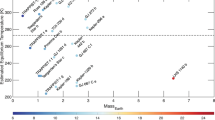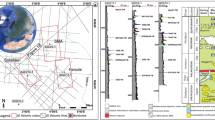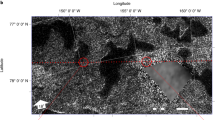Abstract
Europa, the innermost icy satellite of Jupiter, has a tortured young surface1,2,3,4 and sustains a liquid water ocean1,2,3,4,5,6 below an ice shell of highly debated thickness1,2,3,4,5,7,8,9,10. Quasi-circular areas of ice disruption called chaos terrains are unique to Europa, and both their formation and the ice-shell thickness depend on Europa's thermal state1,2,3,4,5,7,8,9,10,11,12,13,14,15,16,17. No model so far has been able to explain why features such as Conamara Chaos stand above surrounding terrain and contain matrix domes10,18. Melt-through of a thin (few-kilometre) shell3,7,8 is thermodynamically improbable and cannot raise the ice10,18. The buoyancy of material rising as either plumes of warm, pure ice called diapirs1,9,10,11,12,13,14,15 or convective cells16,17 in a thick (>10 kilometres) shell is insufficient to produce the observed chaos heights, and no single plume can create matrix domes10,18. Here we report an analysis of archival data from Europa, guided by processes observed within Earth's subglacial volcanoes and ice shelves. The data suggest that chaos terrains form above liquid water lenses perched within the ice shell as shallow as 3 kilometres. Our results suggest that ice–water interactions and freeze-out give rise to the diverse morphologies and topography of chaos terrains. The sunken topography of Thera Macula indicates that Europa is actively resurfacing over a lens comparable in volume to the Great Lakes in North America.
This is a preview of subscription content, access via your institution
Access options
Subscribe to this journal
Receive 51 print issues and online access
$199.00 per year
only $3.90 per issue
Buy this article
- Purchase on Springer Link
- Instant access to full article PDF
Prices may be subject to local taxes which are calculated during checkout



Similar content being viewed by others
References
Pappalardo, R. et al. Geological evidence for solid-state convection in Europa’s ice shell. Nature 391, 365–368 (1998)
Figueredo, P. H. & Greeley, R. Resurfacing history of Europa from pole-to-pole geological mapping. Icarus 167, 287–312 (2004)
Carr, M. H. et al. Evidence for a subsurface ocean on Europa. Nature 391, 363–365 (1998)
Squyres, S. W., Reynolds, R. T., Cassen, P. & Peale, S. J. Liquid water and active resurfacing on Europa. Nature 301, 225–226 (1983)
Cassen, P., Reynolds, R. T. & Peale, S. J. Is there liquid water on Europa? Geophys. Res. Lett. 6, 731–734 (1979)
Kivelson, M. G. et al. Galileo magnetometer measurements: a stronger case for a subsurface ocean at Europa. Science 289, 1340–1343 (2000)
Greenberg, R. G. et al. Chaos on Europa. Icarus 141, 263–286 (1999)
O’Brien, D. P., Geissler, P. & Greenberg, R. A melt through model for chaos formation on Europa. Icarus 156, 152–161 (2002)
Schenk, P. & Pappalardo, R. T. Topographic variations in chaos on Europa: implications for diapiric formation. Geophys. Res. Lett. 31 L16703 10.1029/2004GL019978 (2004)
Collins, G. C., Head, J. W., III, Pappalardo, R. T. & Spaun, N. A. Evaluation of models for the formation of chaotic terrain on Europa. J. Geophys. Res. 105, 1709–1716 (2000)
Spaun, N. A. et al. Conamara Chaos region, Europa: reconstruction of mobile polygonal ice blocks. Geophys. Res. Lett. 25, 4277–4280 (1998)
Rathbun, J. A., Musser, G. S., Jr & Squyres, S. W. Ice diapirs on Europa: implications for liquid water. Geophys. Res. Lett. 25, 4157–4160 (1998)
Pappalardo, R. & Barr, A. C. The origin of domes on Europa: the role of thermally induced compositional diapirism. Geophys. Res. Lett. 31 L01701 10.1029/2003GL019202 (2004)
Head, J. W. & Pappalardo, R. T. Brine mobilization during lithospheric heating on Europa: implications for formation of chaos terrain, lenticular texture, and color variations. J. Geophys. Res. 104 (E11). 27143–27155 (1999)
Sotin, C., Head, J. W. & Tobie, G. Tidal heating of upwelling thermal plumes and the origin of lenticulae and chaos melting. Geophys. Res. Lett. 29 1233 10.1029/2001GL013844 (2002)
McKinnon, W. B. Convective instability in Europa’s floating ice shell. Geophys. Res. Lett. 26, 951–954 (1999)
Han, L. & Showman, A. P. Coupled convection and tidal dissipation in Europa’s ice shell. Icarus 207, 834–844 (2010)
Collins, G. C. & Nimmo, F. in Europa (eds Pappalardo, R. T., McKinnon, W. B. & Khurana, K.) 259–282 (Univ. Arizona Press, 2009)
Björnsson, H. Subglacial lakes and jökulhlaups in Iceland. Glob. Planet. Change 35, 255–271 (2003)
Gudmundsson, M. T., Sigmundsson, F., Bjornsson, H. & Hognadottir, T. The 1996 eruption at Gjalp, Vatnajökull ice cap, Iceland: efficiency of heat transfer, ice deformation and subglacial water pressure. Bull. Volcanol. 66, 46–65 (2004)
Kovacs, A. & Gow, A. J. Brine infiltration in the McMurdo Ice Shelf, McMurdo Sound, Antarctica. J. Geophys. Res. 80, 1957–1961 (1975)
Scambos, T. et al. Ice shelf disintegration by plate bending and hydro-fracture: satellite observations and model results of the 2008 Wilkins ice shelf break-ups. Earth Planet. Sci. Lett. 280, 51–60 (2009)
MacAyeal, D., Scambos, T. A., Hulbe, C. L. & Fahnestock, M. A. Catastrophic ice-shelf break-up by an ice-shelf fragment-capsize mechanism. J. Glaciol. 49, 22–36 (2003)
McCord, T. B. et al. Hydrated salt minerals on Europa’s surface from the Galileo NIMS investigation. J. Geophys. Res. 104 (E5). 11827–11851 (1999)
Carlson, R. W. et al. Sulfuric acid production on Europa: the radiolysis of sulfur in water ice. Icarus 157, 456–463 (2002)
Gaidos, E. & Nimmo, F. Tectonics and water on Europa. Nature 405, 637 (2000)
Nye, J. F. & Potter, J. R. The use of catastrophe theory to analyse the stability and toppling of icebergs. Ann. Glaciol. 1, 49–54 (1980)
Guttenberg, N. et al. A computational investigation of iceberg capsize as a driver of explosive ice-shelf disintegration. Ann. Glaciol. 52, 51–59 (2011)
Mevel, L. & Mercier, E. Large-scale doming on Europa: a model of formation of Thera Macula. Planet. Space Sci. 55, 915–927 (2007)
Blankenship, D. D., Young, D. A., Moore, W. B. & Moore, J. C. in Europa (eds Pappalardo, R. T., McKinnon, W. B. & Khurana, K. ) 631–654 (Univ. Arizona Press, 2009)
Acknowledgements
We thank D. Young, K. Soderlund, A. Barr, J. Greenbaum, J. Leisner and D. MacAyeal for comments and discussions on the development of these concepts. B.E.S. was supported by a fellowship from the Vetlesen Foundation and the Institute for Geophysics of the Jackson School of Geosciences, University of Texas at Austin (UTIG). D.D.B. was supported by NASA, NSF and UTIG. NASA supported the work of G.W.P. and P.M.S.
Author information
Authors and Affiliations
Contributions
B.E.S. and D.D.B. conceived of and actively discussed this project. B.E.S. analysed Galileo imaging data, found and studied terrestrial analogue information, analysed results, formulated the model, calculated values, and wrote the paper. D.D.B. provided discussion and direction, and edited the paper. G.W.P. performed the FFT analysis of Conamara Chaos topography data. P.M.S. produced the original DEM of Conamara and the photoclinometry of Thera Macula.
Corresponding author
Ethics declarations
Competing interests
The authors declare no competing financial interests.
Supplementary information
Supplementary Information
The file contains Supplementary Figures 1-6 with legends, Supplementary Text and additional references. (PDF 1194 kb)
Rights and permissions
About this article
Cite this article
Schmidt, B., Blankenship, D., Patterson, G. et al. Active formation of ‘chaos terrain’ over shallow subsurface water on Europa. Nature 479, 502–505 (2011). https://doi.org/10.1038/nature10608
Received:
Accepted:
Published:
Issue Date:
DOI: https://doi.org/10.1038/nature10608
This article is cited by
-
Planned Geological Investigations of the Europa Clipper Mission
Space Science Reviews (2024)
-
MASPEX-Europa: The Europa Clipper Neutral Gas Mass Spectrometer Investigation
Space Science Reviews (2024)
-
The Europa Clipper Gravity and Radio Science Investigation
Space Science Reviews (2023)
-
Investigating Europa’s Habitability with the Europa Clipper
Space Science Reviews (2023)
-
Exploring the Interior of Europa with the Europa Clipper
Space Science Reviews (2023)
Comments
By submitting a comment you agree to abide by our Terms and Community Guidelines. If you find something abusive or that does not comply with our terms or guidelines please flag it as inappropriate.



